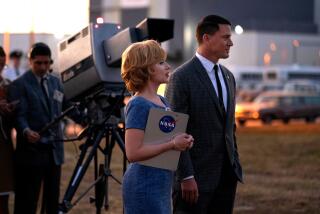Nixon Will Have His Place on the Moon
- Share via
Richard Nixon is going to die. This rude thought came to mind as Nixon passed through the news earlier this year. One week he was the elder statesman advising on arms control, the next he was accepting a medal in France. The French have always liked Nixon. Of course, the French also think that Jerry Lewis is funny.
But one day we won’t have Richard Nixon to kick around, and that will be the end of an era.
Most of us don’t realize that we’re living in the Age of Nixon, but that is how History will see it. History with a capital H, for History haunted Nixon and History was his passion. As President, he always seemed to be looking over his shoulder, wondering what History had just seen him do. He was pictured as an awkward man, strolling down a California beach wearing black leather dress shoes, but it was a lover’s awkwardness--the fear of not deserving History’s attention, let alone her love.
This is the true Nixon--not the disgraced President, but the shamed lover. His notes to her had been made public, he had been made to look like a fool in front of her. It was not impeachment that he feared, but rejection.
In Nixon’s final days at the White House, he roamed the halls with Henry Kissinger and admitted to the haunted feeling, the cold dread, that he had betrayed his love’s confidence. He asked Kissinger to pray with him, to kneel with him. But most important, in the darkened halls in this night of his ruin, Nixon wanted to know one special thing of the Harvard professor: How will History treat me?
The lover’s anguish, lost love’s pain.
Kissinger said what anyone in the role of best friend would say. He reassured the President; he said that the better days would be recalled, the accomplishments, the good times. Give History a while, Kissinger was saying, and she will take you to her bosom.
But will she? Oh, it is strange, but the answer is yes. History, you see, does love love letters, and Nixon sent one of the best. And the letter that he signed is on the moon.
Diamonds never rust, rust never sleeps, and if you put something on the moon it is there forever--footprints, flagpoles, golf balls, lunar landers and the plaque left there by the crew of Apollo XI in July, 1969, the plaque with Richard M. Nixon’s signature under the phrase, “We came in peace.”
Just imagine, a thousand years from now star children will be taught that the 20th Century was notable for one thing and one thing only: We got off the planet Earth--see the Nixon plaque?
Ask King Tut, he’ll tell you. We remember only what we find to remember. That plaque is Plymouth Rock, Amerigo Vespucci’s diary and Queen Isabella’s pawn chit all rolled into one.
Even if we walk into a nuclear winter tomorrow, that plaque will still be there, waiting for some alien archeologist to land and wonder what went wrong. Surely someone could have prevented this tragedy, the alien might think, someone good and powerful who was thrown from power during a crucial century.
Finding the plaque, the alien might decide that Nixon was the one.
The myth of King Arthur started with less.
So either way, ruin or star children, Nixon is set. He doesn’t have to go to France, he doesn’t have to go to China.
He’s on the moon. He’s History.
Unless, the next time we go up there, someone takes along a chisel and . . . .
But that would be wrong . . . wouldn’t it?
More to Read
Get the L.A. Times Politics newsletter
Deeply reported insights into legislation, politics and policy from Sacramento, Washington and beyond. In your inbox twice per week.
You may occasionally receive promotional content from the Los Angeles Times.










